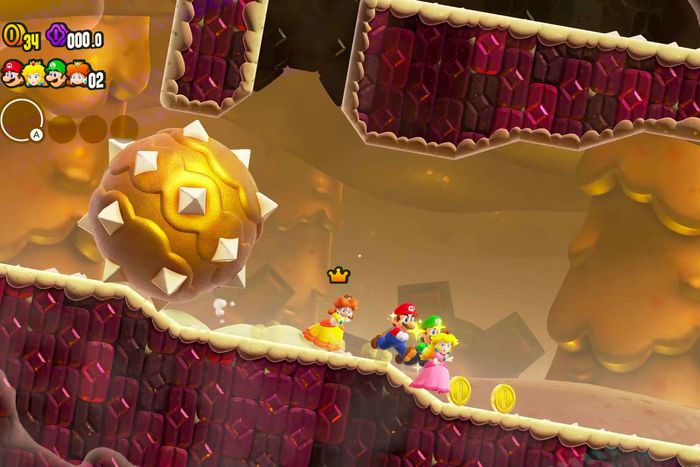
We take for granted that Mario is weird. No, look past the obvious dorm-room observation that those are magic mushrooms, man. In Super Mario Sunshine, Mario is forced into community service for the crime of vandalizing the tropical city he’s vacationing in. (He was framed, of course.) In Super Mario Odyssey, we learn that Mario isn’t technically a human being after he arrives in New Donk City, a Manhattan-inspired world populated by actually normal-looking people. Stuff like this happens with pop-culture iconography all the time; they stick around long enough that we just accept their weirdness as immutable facts. It is now custom that superheroes wear tights, for example, or that mutant turtles favor pizza. But Mario’s capacity for weirdness is particularly capacious. Across his 42 years of existence, our stout hero has traversed galaxies, corporeal forms, even professions. By the time we remember he rides a dinosaur named Yoshi, nothing feels more natural.
Super Mario Bros. Wonder, Nintendo’s first brand-new 2-D Mario side-scroller in over a decade, is amply weird. Our journey begins with Mario and friends parading into the Flower Kingdom just as Bowser shows up to seize a Wonder Flower, a magical plant whose main property is to cause the entire universe to weird out. This botanical heist rips a hole in reality, causing Bowser to physically merge with a castle — he spends the rest of the game as a sentient building — and forcing the kingdom into various states of subjugation. Aided by Prince Florian, the land’s caterpillar monarch, Mario and friends must save the day once again.
Mainline Mario games are often defined by a novel central mechanic, or gimmick, with the more effective ones unlocking a fresh angle on the franchise and the platformer as a genre. Super Mario 64, released way back in 1996, allowed players to barrel through the Mushroom Kingdom in 3-D for the first time, a term of engagement that the later Super Mario Galaxy series would push to its very limits. Super Mario Sunshine’s water pack introduced a buoyant sense of verticality. Super Mario Odyssey saw Mario using a member of a caplike species to assume control, Kirby-style, over enemies or aspects of the environment, thus nudging players to seriously consider the world they’re moving through. In Super Mario 3D World, Mario became a wall-climbing cat.
Wonder’s primary gimmick is less a mechanical conceit than an artistic one. Each main level in the game hides a secret Wonder Flower whose attainment operationalizes the weirdness inherent to the Mario aesthetic. (Not that the Flower Kingdom wasn’t plenty strange to begin with. The world is dotted with talking flowers that speak in a voice recalling Bo Burnham’s Socko: “I believe in you!” they yell. “Take your time!”) Grabbing a Wonder Flower causes the reality of the level to warp in unpredictable ways. The music turns feverish, colors more vivid. Pipes may come to life. Toad may stretch out into the shape of a beanpole. In the very second level of the game, the Wonder Flower causes a cabaret of Piranha Plants to emerge for a musical number. These fantastical transformations are intimately linked to the level’s premise, and in that sense, one can think about the game as being structured like an extended comedy routine: Each course is built around a premise whose punch line is extracted by the Wonder Flower. One level, which at first sees you navigating around bull-like creatures, weirds out by erupting into a stampede you must successfully ride to the end.
I like Super Mario Bros. Wonder a whole lot. The game is a fine entry to the canon of Mario platformers, though I’d be hard-pressed to consider it groundbreaking on any mechanical level. Wonder does try to add a new layer with its new badge system. Players can swap out for different advantages into a run, like the ability to swim faster or float instead of fall. But while some badges do radically change how you can master a level, the system as a whole doesn’t really let players explore the idea of constructing different builds. Some badges are meant to be straightforward solutions for certain levels.
The larger cast of playable characters represents another missed opportunity. Regardless if you roll with the taller Luigi or any of the stalwart Toads, they all play the same — save for Nabbit and the Yoshis, which seem to represent kid-friendly options in that they are invulnerable to enemy attacks but are unable to use power-ups like the standard Fire Flowers and newer ones like the meme-hungry Elephant ball.
2015’s Super Mario Maker, which lets players design and share their own 2-D Mario levels, invited an interesting question as to whether Nintendo placed itself in a bind with its side-scrollers. The nature of those products creates a problem for the company by placing any new level it releases up against the theoretically infinite expanse of mass-civilian creativity. (Have you seen some of these creations!?) Adding further texture to this question is the parallel fact that platformers have largely fallen out of industry vogue; it’s rare to hear about major developers investing much in the genre anymore. It continues to find vibrant life in the indie space, however, with smaller teams using the genre to explore an array of themes and moods. Celeste, one of the finest games to come out in the past decade, uses the challenge of its platforming to meditate on a life that successfully co-exists with anxiety. Playdead’s Limbo and Inside conjure gorgeous visions of German Expressionist dread through its shadowy aesthetic. Up against the infinite expanse of its own Super Mario Maker user base and the artistic focus of the indie space, what creative terrain does Nintendo occupy with its own Mario platformers moving forward?
Wonder underscores what has always been Nintendo’s solution to this problem. The magic of Wonder lies in the cumulative delights, emphasizing how the pleasures of Mario, and Nintendo broadly, are rarely just about the strengths of its gameplay. Mario is equally about Nintendo’s penchant for a ringmaster’s showmanship: Each level reaches for an energizing loop of surprise and satisfaction, each moment seeking to be pleasurable and rewarding in its own way. In this, there remains a throwback quality to Mario that evokes a timeless interest in video games as engines of delight even as it pushes for mechanical experimentation — except that Wonder doesn’t entirely feel like a hermetically sealed throwback. Indeed, this is perhaps the first mainline Mario game that aggressively wears its external inspirations on its sleeve. (Is that a Limbo reference I see?)
Weirdness, accentuated by a sense of flair, is a fundamental pillar of the Mario experience. This is a huge reason why The Super Mario Bros. Movie felt so creatively impoverished. That Hollywood creation is mere paper-thin pleasure, a nonsense candy corn of a thing that barely features any surprise, idiosyncrasy, or respect for the viewer. (In hindsight, it makes the 1993 disaster feel more spiritually aligned with the franchise.) What’s so unnerving about the Illumination film is what it may portend for Nintendo, which is steadily growing in ambition as it seems to be entering a new corporate era. Nintendo wants to produce more movies from its intellectual properties. It makes theme parks now. Once a company that agonized over making a Mario for the smartphone, there’s something unbridled about Nintendo today. Will its games stay weird? One can only hope, but with Wonder, there’s reason to be optimistic.


